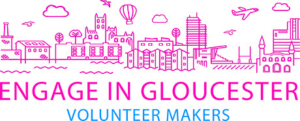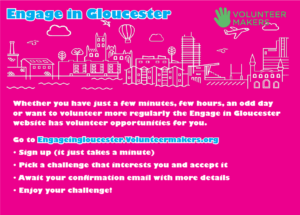How Gloucester put itself at the forefront of innovative community engagement
Getting the community engaged and involved in arts, heritage and culture, has long been an aim of civic bodies in Gloucester.

It’s an approach that both carries economic benefits, and individual ones: letting the city council support events and facilities, and promoting physical and mental wellbeing and social inclusion for residents.
The West Country city has been a successful adopter of a new engagement model and technology – Volunteer Makers – to aid these aims.
Gloucester Heritage Forum and other community groups established Engage in Gloucester a year ago, to pool ideas and resources and use the platform provided by Tickbox, a digital tech company based just down the road in Bristol. Tickbox’s vision is to build technology products that have a positive impact on the world, Volunteer Makers has been rolled out nationally – supported by Creative England and Arts Council England.
The results achieved by Engage in Gloucester, using Volunteer Makers, not only provided community and civic projects with more public participation, but brought younger supporters into the fold – a key ambition for the Council.
“Engage in Gloucester with Volunteer Makers has not only increased the number of volunteers, it has enabled a better engagement with the public and increased the scope of their involvement with community groups and projects,” says Sarah Orton, Gloucester Culture Trust’s Community Engagement and Volunteer Officer.
Engage in Gloucester’s Volunteer Makers platform has been used by nearly 60 groups based in or near the city, ranging from Gloucester City Museum and Archives, to a community gardening group and the Girl Guides.
Larger organisations often write their own volunteer “challenges” (opportunities) for supported participation, while Sarah co-ordinates and helps smaller groups write and manage theirs.
“It has tapped into the changing face of community engagement,” Sarah explains.
“People being able to offer a few hours here and there and dip into what they want to do and where they want to do it.
“We’ve seen a big increase in young volunteers. Sometimes students looking for experience, perhaps to put on their UCCA form or to gain a foothold in the heritage and charity sector; young people doing their Duke of Edinburgh Awards and others who just want to help out, maybe in a gap year.
“The technology suits them to the ground and helps them connect, though of course, we still have plenty of older users as well, including retired people.”
Micro-volunteering is what Volunteer Makers encourages, letting supporters match their skills and interests and give time as and when they can, to help charities achieve specific goals.
“We’ve seen people grow in confidence. One regular volunteer now has paid work in the sector.
“For all, it helps that the volunteer challenges mean it isn’t a case of ‘turn up and do what we ask you’ but supporters know what their role will be, they will understand what they’re doing – and are consequently more enthusiastic about it!”
Engage in Gloucester can list many notable successes: stewarding posts for the city carnival and other festivals are filled “almost instantly”, while data inputting roles at the city archives and local history festival, both in situ and as home-based work, have also proved very popular. A drop-in counselling service filled demanding ongoing receptionist roles thanks to Engage in Gloucester and Volunteer Makers. Environmental challenges have also “flown off the shelf”, as Sarah puts it.
“Flexibility is what makes it work for users – not everyone can give regular commitments, but many want to help out as-and-when.
“Our community groups say they are seeing a very high calibre of volunteer come forward. Volunteer Makers has really made a difference to how charity and community groups and events operate here. It’s been great!”
It’s just worked really well for us” Sarah concludes.

 make the most of your mailing assets – to existing volunteers and supporters (all GDPR compliant of course!), direct emails (add a clickable banner to the footer of all staff emails) or newsletter articles.
make the most of your mailing assets – to existing volunteers and supporters (all GDPR compliant of course!), direct emails (add a clickable banner to the footer of all staff emails) or newsletter articles. “I’ve got three pull up banners, logoed stickers and postcards to advertise the site. I go out to events such as the History Festival, residents’ weekend, local community shows and have a stall, chat to people about the site and hand out the postcards and stickers. I also made sure that the postcards are a bit thicker and substantial so they don’t just get immediately discarded and they also work as bookmarks” (Sarah Orton,
“I’ve got three pull up banners, logoed stickers and postcards to advertise the site. I go out to events such as the History Festival, residents’ weekend, local community shows and have a stall, chat to people about the site and hand out the postcards and stickers. I also made sure that the postcards are a bit thicker and substantial so they don’t just get immediately discarded and they also work as bookmarks” (Sarah Orton, 